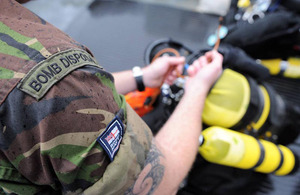Royal Navy explodes World War Two bomb in Plymouth
A Second World War bomb that caused disruption when it was discovered during excavation work in Plymouth city centre last week was dealt with by the Royal Navy's Devonport-based bomb disposal unit.

A Royal Navy diver from Southern Diving Unit 1 prepares to don his diving gear [Picture: LA(Phot) James Crawford, Crown Copyright/MOD 2010]
The highly successful combined operation used the resources of the emergency services and the assets of the Royal Navy bomb disposal team, Southern Diving Unit 1.
The 70kg German bomb was taken out to Plymouth Sound via Millbay Docks and detonated safely in a controlled explosion.
At approximately 1615hrs on Thursday 11 November 2010, Southern Diving Unit 1’s duty watch, led by Lieutenant Commander Richard Talbot, was called to Plymouth city centre where the bomb, in a poor condition, had been discovered during excavation works in Nott Street.
In addition to the four-man team, Warrant Officer Robin Rickard acted as the liaison officer with the emergency services. On arrival, the initial task was to positively identify the object and, once this was complete, a 250-metre cordon was established in consultation with the police, ambulance and fire service.
It became apparent early on that the bomb could not be destroyed where it was found due to time constraints and other secondary hazards in the area, most notably asbestos.

A Royal Navy diver prepares to dive to the bomb in Plymouth Sound in order to set the explosive charges [Picture: LA(Phot) James Crawford, Crown Copyright/MOD 2010]
A procedure known as ‘fuze immunisation’ was used to desensitise the bomb and make it safe to move; and once this was achieved it was moved under police escort to Millbay Docks where it was transferred to a diving vessel and transported out into Plymouth Sound.
The item was lowered to the seabed and marked over night. Then, on the morning of Friday 12 November, the team went out to the site and using diver-placed explosive charges successfully and safely detonated the bomb in a controlled underwater explosion.
Lt Cdr Talbot, who was the duty operator in charge of the task, described what he had to do:
In order to move the item safety, a procedure called fuze immunisation was carried out. I drilled into the fuse pocket of the bomb by hand, then inserted a highly concentrated saline solution to desensitise the bomb.
Once this was done and a period of time was observed to allow the desensitising to happen the munition was then moved by road to Millbay Docks under police escort where it was transferred to a Southern Diving Unit 1 diving vessel and transported to a safe area in Cawsand Bay.
The Commanding Officer of the Southern Diving Group, Lieutenant Commander John Beavis, who was away on duty in Scotland, said of the mission:
Once the bomb was removed to a safe location it was sympathetically detonated with an explosive sonar charge and made safe at 1200hrs today.
This was another example of the daily business and daily activity of the Southern Diving Group and the Fleet Diving Squadron; I was extremely pleased with the outcome and it was indeed a sterling success.
Southern Diving Unit 1 works around the clock to deal with explosive ordnance discovered in the coastal areas of the South West and Wales. The potentially hazardous ordnance is reported via the police and can vary from discarded emergency flares to military mines, grenades and bombs, often of World War Two origin and occasionally earlier.
Apart from tasks such as those carried out by Southern Diving Unit 1, Royal Navy divers also serve with their Army bomb disposal colleagues in Afghanistan where they are involved in the vital work of dealing with deadly improvised explosive devices threatening coalition troops, Afghan forces and Afghan civilians.